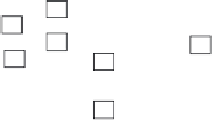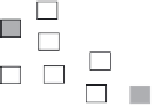what-when-how
In Depth Tutorials and Information
our data. Sometimes, we may have much data, but a lack of information; hence,
the original data will be reduced to a representative set of vectors (only relevant
information from the input data will be considered for performing the task). he
relation extraction will be used whenever there is a clear relationship between
clients or users.
In this section, we will discuss the procedure for relation extraction, present
some experimental outcomes, explain how to solve the problem and, finally, pro-
pose some ideas and hints for potential work in that area.
he goal of social network analysis is to measure the relationship and informa-
tion lows between individuals, groups, and people inside the network. We have to
keep in mind that one of our important objectives is to discover a linear combina-
tion of relations that best describes movements or actions taking place between
users in the social network.
It is undeniable that there are many relations in a social network. he way those rela-
tions are set or established will tell us what kind of social network we are dealing with.
Furthermore, they will help us know whether or not the social network is dynamic. To
understand the relation extraction problem, we will consider two examples.
In the first example (Figure 16.2), let us consider a network that consists of
four objects, with assume that any users linked to those four objects are part of
the community. Suppose that in that social network, we have eight other nodes
surrounding the four objects. Network A has two nodes connected to the four
objects, with the remaining nodes are linked together. Also, let a network B
be designed as one node connected to two objects, another node linked to two
objects, and the last six nodes connected to one another. Finally, let us assume a
network C with two nodes connected to each object. Obviously, we can see that
network A best represents the community structure. In design A, the four objects
are grouped together with some nodes, creating a strong relation between users.
Designs B and C, on the other hand, do not have their four objects assembled
Network A
Network B
Network C
Figure 16.2
Relationships in networks. (From Cai, D. et al. 2005. Mining hid-
den community in heterogeneous social networks. In
Proceedings of the 3rd
International Workshop on Link Discovery
(Chicago,Illinois,August21-25,2005).
LinkKDD'05.ACM,NewYork,58-65.)










